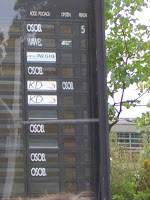 My train was 3 hours late, so I was rather ready to get out of my second- hand Slovenian sleeper compartment as the train finally neared the Capital of Macedonia. I had read a lot about the country, and heard it constantly spoken of as the birthplace of Old Church Slavonic by Slavic linguistics majors who I knew. As the train crested the hill, and the skyline of Skopje came into view I was shocked to count 2 short church steeples and 8 towering minarets.
My train was 3 hours late, so I was rather ready to get out of my second- hand Slovenian sleeper compartment as the train finally neared the Capital of Macedonia. I had read a lot about the country, and heard it constantly spoken of as the birthplace of Old Church Slavonic by Slavic linguistics majors who I knew. As the train crested the hill, and the skyline of Skopje came into view I was shocked to count 2 short church steeples and 8 towering minarets.
While I have been to both heavily Muslim and Christian countries around the globe, no city so effectly blurs the lines between the two like Skopje. While the two populations live distinctly in different neighborhoods overlap occurs throughout the city. Women in burkhas, and men in prayer caps walk in front of the site where Mother Teresa was born. Bars and advertisements for the local beer abound in the Christian section of the city, but are conspicuously absent in the Albanian-Turkish neighborhood on the hill across the river, where it is common to see restaurants with Arabic names. It was a surreal feeling to hear the ringing of the church bells join with the call to prayer.
In many other Balkan countries , Orthodox and Muslim groups have turned to violence.
Although I have heard that there is some tension beneath the surface in Macedonia the two groups, while largely segregated, seem to live in relative peace. I simply point out that the city of Skopje stands as an example that such piece is possible in the Balkans and elsewhere..






 This is my fourth time in Poland. However, it was not
This is my fourth time in Poland. However, it was not 
